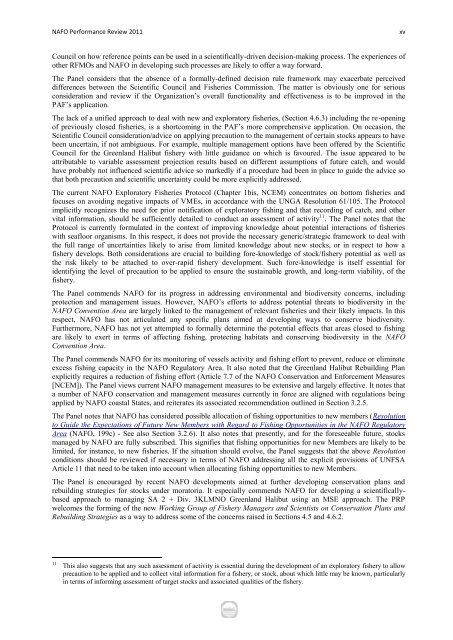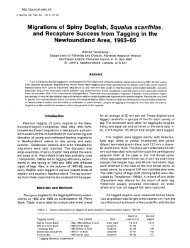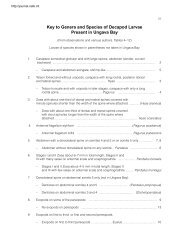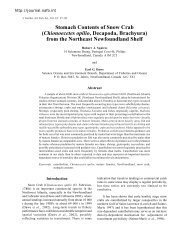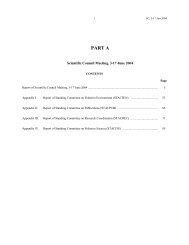Report of the NAFO Performance Review Panel - Northwest Atlantic ...
Report of the NAFO Performance Review Panel - Northwest Atlantic ...
Report of the NAFO Performance Review Panel - Northwest Atlantic ...
Create successful ePaper yourself
Turn your PDF publications into a flip-book with our unique Google optimized e-Paper software.
<strong>NAFO</strong> <strong>Performance</strong> <strong>Review</strong> 2011xvCouncil on how reference points can be used in a scientifically-driven decision-making process. The experiences <strong>of</strong>o<strong>the</strong>r RFMOs and <strong>NAFO</strong> in developing such processes are likely to <strong>of</strong>fer a way forward.The <strong>Panel</strong> considers that <strong>the</strong> absence <strong>of</strong> a formally-defined decision rule framework may exacerbate perceiveddifferences between <strong>the</strong> Scientific Council and Fisheries Commission. The matter is obviously one for seriousconsideration and review if <strong>the</strong> Organization‘s overall functionality and effectiveness is to be improved in <strong>the</strong>PAF‘s application.The lack <strong>of</strong> a unified approach to deal with new and exploratory fisheries, (Section 4.6.3) including <strong>the</strong> re-opening<strong>of</strong> previously closed fisheries, is a shortcoming in <strong>the</strong> PAF‘s more comprehensive application. On occasion, <strong>the</strong>Scientific Council consideration/advice on applying precaution to <strong>the</strong> management <strong>of</strong> certain stocks appears to havebeen uncertain, if not ambiguous. For example, multiple management options have been <strong>of</strong>fered by <strong>the</strong> ScientificCouncil for <strong>the</strong> Greenland Halibut fishery with little guidance on which is favoured. The issue appeared to beattributable to variable assessment projection results based on different assumptions <strong>of</strong> future catch, and wouldhave probably not influenced scientific advice so markedly if a procedure had been in place to guide <strong>the</strong> advice sothat both precaution and scientific uncertainty could be more explicitly addressed.The current <strong>NAFO</strong> Exploratory Fisheries Protocol (Chapter 1bis, NCEM) concentrates on bottom fisheries andfocuses on avoiding negative impacts <strong>of</strong> VMEs, in accordance with <strong>the</strong> UNGA Resolution 61/105. The Protocolimplicitly recognizes <strong>the</strong> need for prior notification <strong>of</strong> exploratory fishing and that recording <strong>of</strong> catch, and o<strong>the</strong>rvital information, should be sufficiently detailed to conduct an assessment <strong>of</strong> activity 11 . The <strong>Panel</strong> notes that <strong>the</strong>Protocol is currently formulated in <strong>the</strong> context <strong>of</strong> improving knowledge about potential interactions <strong>of</strong> fisherieswith seafloor organisms. In this respect, it does not provide <strong>the</strong> necessary generic/strategic framework to deal with<strong>the</strong> full range <strong>of</strong> uncertainties likely to arise from limited knowledge about new stocks, or in respect to how afishery develops. Both considerations are crucial to building fore-knowledge <strong>of</strong> stock/fishery potential as well as<strong>the</strong> risk likely to be attached to over-rapid fishery development. Such fore-knowledge is itself essential foridentifying <strong>the</strong> level <strong>of</strong> precaution to be applied to ensure <strong>the</strong> sustainable growth, and long-term viability, <strong>of</strong> <strong>the</strong>fishery.The <strong>Panel</strong> commends <strong>NAFO</strong> for its progress in addressing environmental and biodiversity concerns, includingprotection and management issues. However, <strong>NAFO</strong>‘s efforts to address potential threats to biodiversity in <strong>the</strong><strong>NAFO</strong> Convention Area are largely linked to <strong>the</strong> management <strong>of</strong> relevant fisheries and <strong>the</strong>ir likely impacts. In thisrespect, <strong>NAFO</strong> has not articulated any specific plans aimed at developing ways to conserve biodiversity.Fur<strong>the</strong>rmore, <strong>NAFO</strong> has not yet attempted to formally determine <strong>the</strong> potential effects that areas closed to fishingare likely to exert in terms <strong>of</strong> affecting fishing, protecting habitats and conserving biodiversity in <strong>the</strong> <strong>NAFO</strong>Convention Area.The <strong>Panel</strong> commends <strong>NAFO</strong> for its monitoring <strong>of</strong> vessels activity and fishing effort to prevent, reduce or eliminateexcess fishing capacity in <strong>the</strong> <strong>NAFO</strong> Regulatory Area. It also noted that <strong>the</strong> Greenland Halibut Rebuilding Planexplicitly requires a reduction <strong>of</strong> fishing effort (Article 7.7 <strong>of</strong> <strong>the</strong> <strong>NAFO</strong> Conservation and Enforcement Measures[NCEM]). The <strong>Panel</strong> views current <strong>NAFO</strong> management measures to be extensive and largely effective. It notes thata number <strong>of</strong> <strong>NAFO</strong> conservation and management measures currently in force are aligned with regulations beingapplied by <strong>NAFO</strong> coastal States, and reiterates its associated recommendation outlined in Section 3.2.5.The <strong>Panel</strong> notes that <strong>NAFO</strong> has considered possible allocation <strong>of</strong> fishing opportunities to new members (Resolutionto Guide <strong>the</strong> Expectations <strong>of</strong> Future New Members with Regard to Fishing Opportunities in <strong>the</strong> <strong>NAFO</strong> RegulatoryArea (<strong>NAFO</strong>, 199c) - See also Section 3.2.6). It also notes that presently, and for <strong>the</strong> foreseeable future, stocksmanaged by <strong>NAFO</strong> are fully subscribed. This signifies that fishing opportunities for new Members are likely to belimited, for instance, to new fisheries. If <strong>the</strong> situation should evolve, <strong>the</strong> <strong>Panel</strong> suggests that <strong>the</strong> above Resolutionconditions should be reviewed if necessary in terms <strong>of</strong> <strong>NAFO</strong> addressing all <strong>the</strong> explicit provisions <strong>of</strong> UNFSAArticle 11 that need to be taken into account when allocating fishing opportunities to new Members.The <strong>Panel</strong> is encouraged by recent <strong>NAFO</strong> developments aimed at fur<strong>the</strong>r developing conservation plans andrebuilding strategies for stocks under moratoria. It especially commends <strong>NAFO</strong> for developing a scientificallybasedapproach to managing SA 2 + Div. 3KLMNO Greenland Halibut using an MSE approach. The PRPwelcomes <strong>the</strong> forming <strong>of</strong> <strong>the</strong> new Working Group <strong>of</strong> Fishery Managers and Scientists on Conservation Plans andRebuilding Strategies as a way to address some <strong>of</strong> <strong>the</strong> concerns raised in Sections 4.5 and 4.6.2.11This also suggests that any such assessment <strong>of</strong> activity is essential during <strong>the</strong> development <strong>of</strong> an exploratory fishery to allowprecaution to be applied and to collect vital information for a fishery, or stock, about which little may be known, particularlyin terms <strong>of</strong> informing assessment <strong>of</strong> target stocks and associated qualities <strong>of</strong> <strong>the</strong> fishery.


